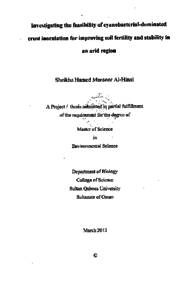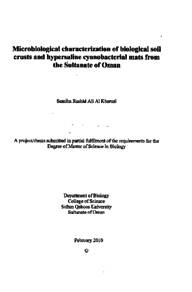وثيقة
Investigating the feasilibility of cyanobacterrial-dominated crust inoculation for improving soil fertility and stability in an arid region.
الناشر
Sultan Qaboos University
ميلادي
2013
اللغة
الأنجليزية
الملخص الإنجليزي
Biological soil crusts (BSCs) are a critical and unique part in their ecosystems, particularly in arid and semi-arid regions. Due to their documented positive effects on their ecosystems, they are receiving an increasing attention. Practical testing of the feasibility of artificially inoculating cyanobacterial-dominated biological soil crust into erosive soil to improve its stability and fertility was conducted in this study. The experiment evaluated the effect of inoculation mass (3g vs 5g), inoculation mode (fragment vs slurry), and watering frequency (3 vs 5 days per week) on inoculation development, chlorophyll a content, soil nitrate concentration and soil stability,
After three months of inoculation, the results showed that: (1) it was feasible to grow cyanobacterial-dominated biological soil crusts under natural environmental conditions and (2) man-made cyanobacterial crusts enhanced soil stability and fertility although they exhibited a decrease in soil nitrate concentration in the first weeks of inoculation. Economically, our results suggested that the inoculation of low mass, slurry inocula and a watering frequency of three days per week (LSW3) was suitable to artificially grow biological crusts and enhance soil stability and fertility in the hyperarid conditions of soil.
المجموعة
URL المصدر
الملخص العربي
القشور البيولوجية للتربة (BSCs) جزء فريد وهام من نوعه في النظام البيني و خاصة في المناطق الجافة و شبه الجافة. نظرا لأثارها الإيجابية على التربة, هناك قدرا متزايدا من الاهتمام بها. في هذا البحث أجري اختبار عملي لمعرفة إمكانية زراعة قشرة بيولوجية في التربة و تحسين خصوبتها و تماسكها و ذلك باستخدام قشرة بيولوجية طبيعية تسودها السيانوبكتريا (Cyanobacteria). اهتم البحث بدراسة تأثير كل من كمية التطعيم (3 جرام و 5 جرام), كيفية التطعيم (طيني و قطع) و كمية المياه (3 أيام كل اسبوع و 5 أيام كل أسبوع على نمو القشرة البيولوجية, كمية الصبغة الخضراء (الكلوروفيل), تركيز النيتروجين و تماسك التربة بع ثلاثة أشهر من التطعيم أظهرت النتائج ما يلي: (1) امكانية نمو القشرة البيولوجية تحت الظروف البيئية الطبيعية. (2) زيادة تماسك التربة وخصوبتها بعد التطعيم على الرغم من انخفاض نسبة النيتروجين في الأسابيع الأولى من التطعيم و (3) تطعيم التربة ب 3 جرام من القشرة البيولوجية على شكل طيني وريها 3 أيام في الأسبوع (Lsw3) يعتبر طريقة مناسبة لزيادة خصوبة التربة و تماسكها.
قالب العنصر
الرسائل والأطروحات الجامعية


